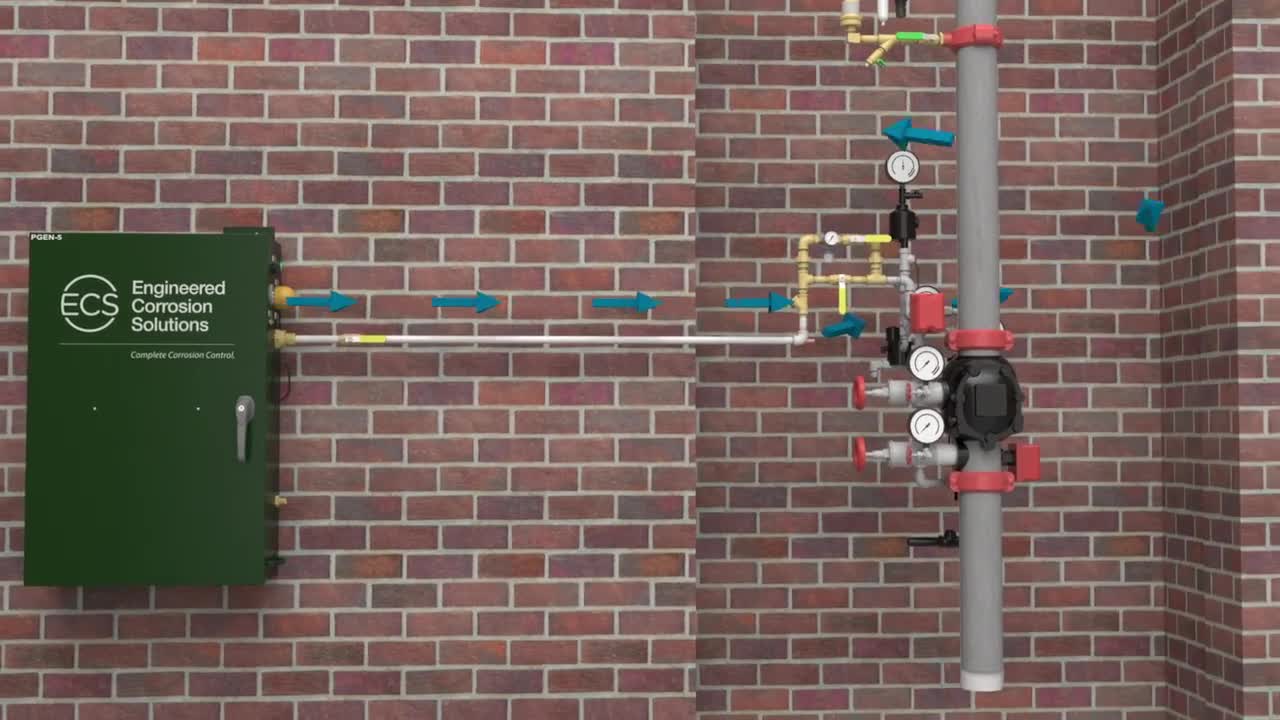Dry Pipe Nitrogen Inerting (DPNI) accomplishes the goal of removing oxygen from sprinkler system piping using fill and purge breathing, which is a patented pressure cycling process unique to ECS.
This process occurs automatically while the fire sprinkler system is in service and does not impact the ability of the system to respond to a fire.
Fill and Purge Breathing with DPNI
Watch the video below for a visual representation of the fill and purge breathing process:

Fill Cycle
During the fill cycle, 98% nitrogen gas from a nitrogen generator enters the system piping at a rate that causes the pressure within the entire piping network to increase.
The fill cycle results in:
| 1. The oxygen concentration within the piping atmosphere is diluted and the nitrogen concentration is enriched. | 2. By injecting nitrogen gas at a rate which increases the pressure within the pipeline, the gases experience dynamic mixing as nitrogen gas moves from the injection port deep into the closed piping network. Gas mixing is extremely efficient using this method. | 3. As gas movement and mixing occurs, the composition of the gas within the piping network homogenizes so that pockets of high oxygen concentration are quickly diluted. |
Purge Cycle
During the purge cycle the nitrogen-enriched gas within the piping is vented at a rate that causes system pressure to gradually drop.
The purge cycle results in:
| 1. When the vent is open all of the gas within the piping begins to move toward the pressure drop that occurs at the vent. | 2. The gas within the piping becomes more and more homogeneous as dynamic mixing occurs and the gas moves. | 3. When the purge portion of the pressure cycle is completed, a portion of the unreacted oxygen has been permanently removed from the piping so it cannot corrode the pipe. |
Each sequential fill and purge breathing cycle dilutes the concentration of oxygen further and enriches the concentration of nitrogen gas in the piping network.
When the concentration of the gas within the system piping reaches the same purity of the injected gas, i.e. 98% nitrogen and 2% oxygen, the fill and purge breathing process is stopped and the fire sprinkler system is considered fully inerted.
Continuous Venting
Continuously venting the fire sprinkler system piping with 98% nitrogen gas and 2% oxygen gas will cause a significant amount of corrosion damage over the long term.
The cumulative amount of oxygen gas that is added to the piping, even at a concentration of 2%, damages the piping at any location where there is trapped water. To avoid this cumulative corrosion effect, ECS never recommends continuous venting.
We originally developed the industry's first automatically closing dry vent, the ECS Protector Dry SMART Vent, to eliminate the opportunity for human error to create a corrosive environment while also removing the labor required to close manual vents.
Some within the industry have proposed continuous venting as a feature that removes water, or dries the system. Unfortunately, this is not completely accurate. While high purity nitrogen gas is very dry compared to atmospheric gas, it would require a very significant volume of high purity nitrogen over a long period of time (using continuous venting) to completely remove pools of trapped water in a typical dry pipe sprinkler system. As previously described, the process of continuous venting can be very damaging to system piping.
Gas & Water Flow In A Dry or Preaction Fire Sprinkler System
Fill and purge breathing is well suited to displace one gas with another in any closed vessel. There are several variables that must be considered to design a fill and purge breathing process, such as the volume of the vessel, fill rate, vent rate, and vent location.
The relative densities of the displacing gas from the gas being displaced must also be considered. In this case the displacing gas is nitrogen and the gas being displaced is oxygen. The density of nitrogen gas and oxygen are very close to the same. Note that nitrogen gas already makes up approximately 78% of the gas volume in the pipe before the fill and purge breathing process is initiated.
The piping design that is most commonly used for a dry or preaction fire sprinkler system is called a “tree” system. This design means that there is generally no reproducible grid pattern as might be found in a wet pipe fire sprinkler system. One of the attributes of a “tree” system is that the piping design will likely have many branch lines that terminate with a sprinkler which is attached to the smallest diameter piping in the system (a dead end). This can result in a complex and irregular system layout as the piping is installed to provide proper coverage while avoiding obstructions.
Learn More About Fill and Purge Breathing
Put simply, fill and purge breathing is the most effective and efficient process for displacing corrosive oxygen gas in a complex system.
For a more comprehensive analysis of the fill and purge process, download our free white paper, The Effective Use of “Fill and Purge” Pressure Cycling During Dry Pipe Nitrogen Inerting (DPNI) for Corrosion Control, below.


